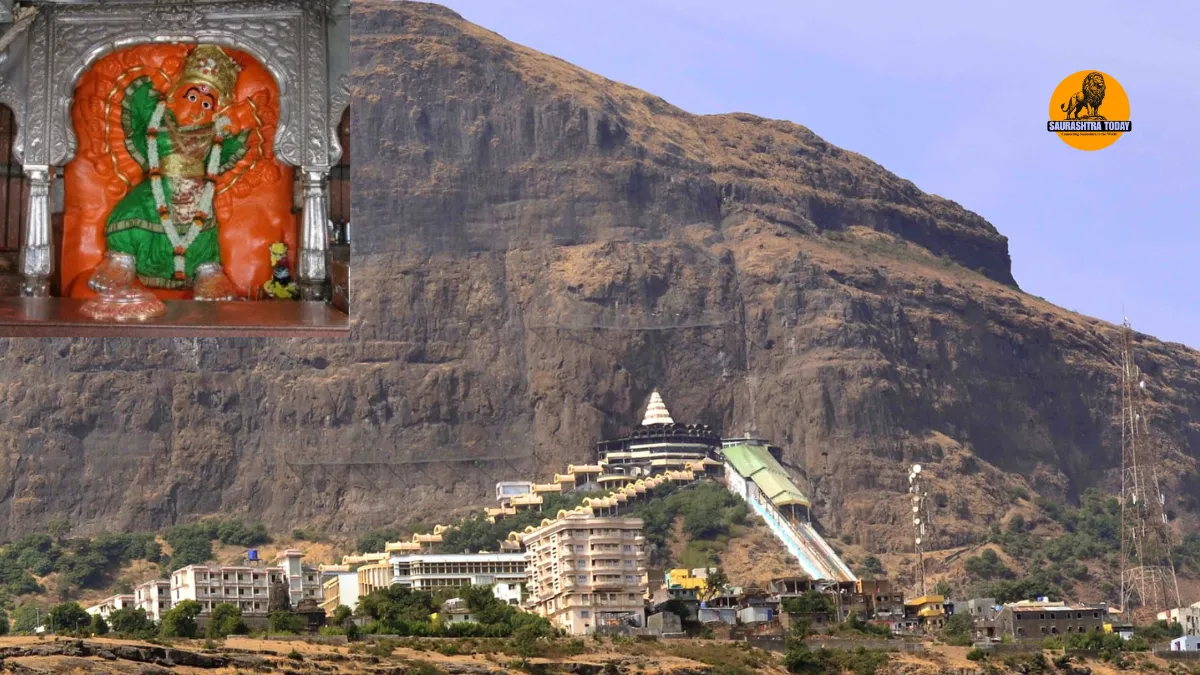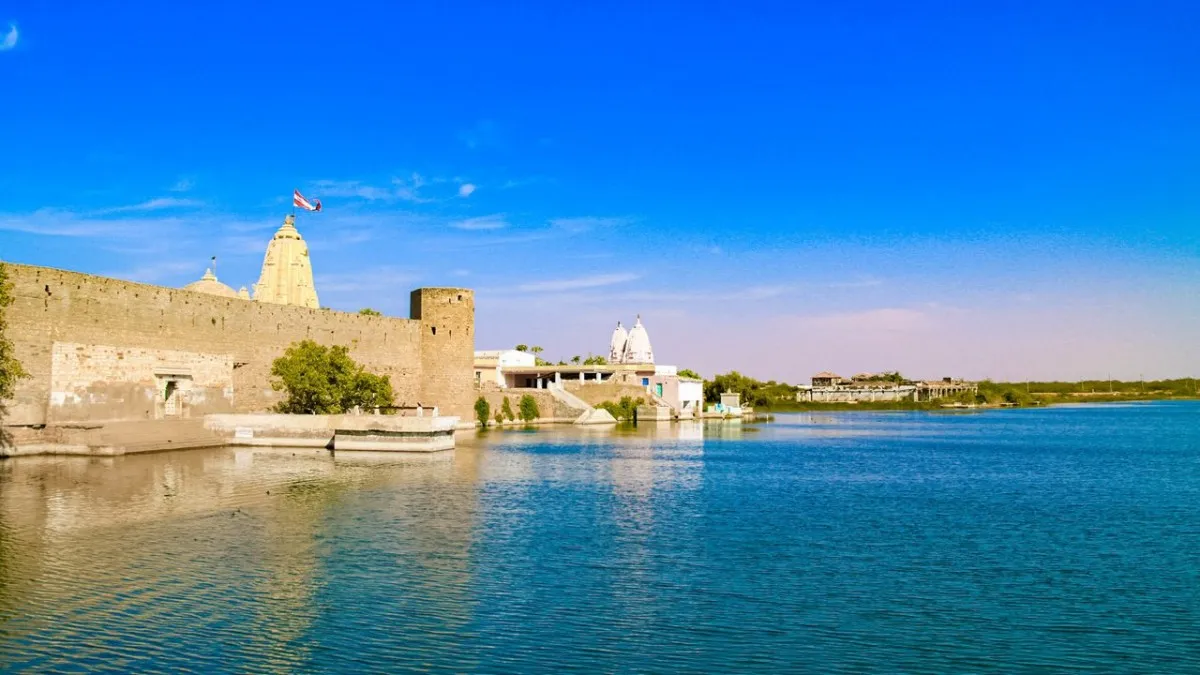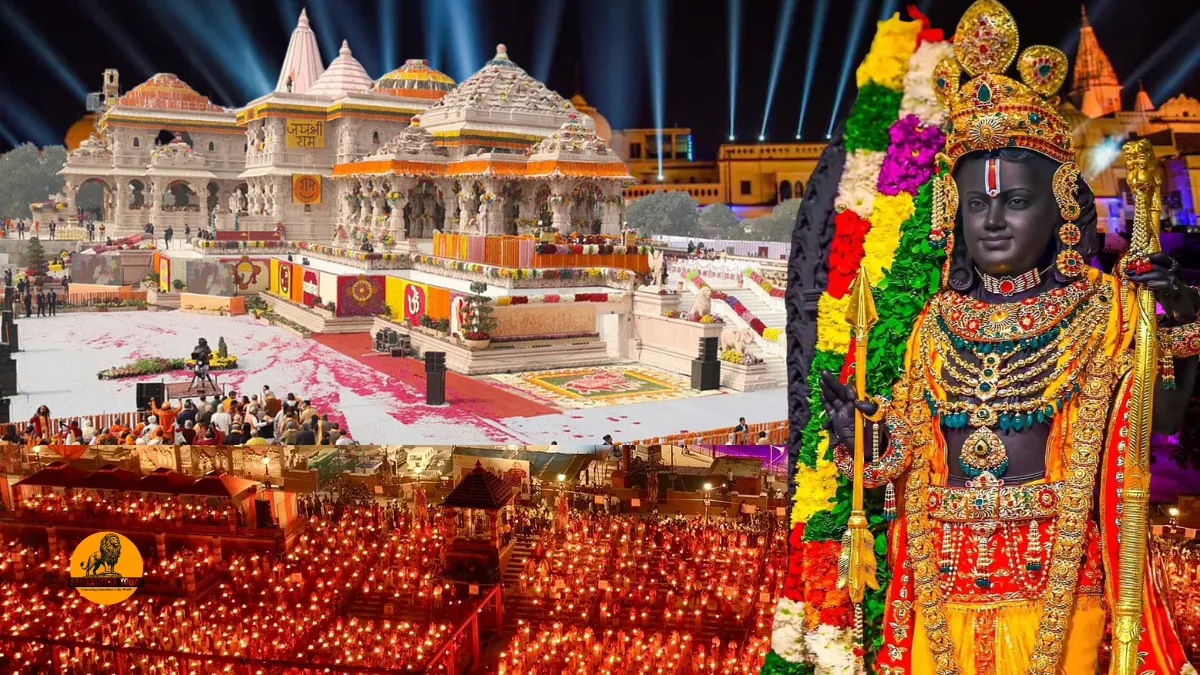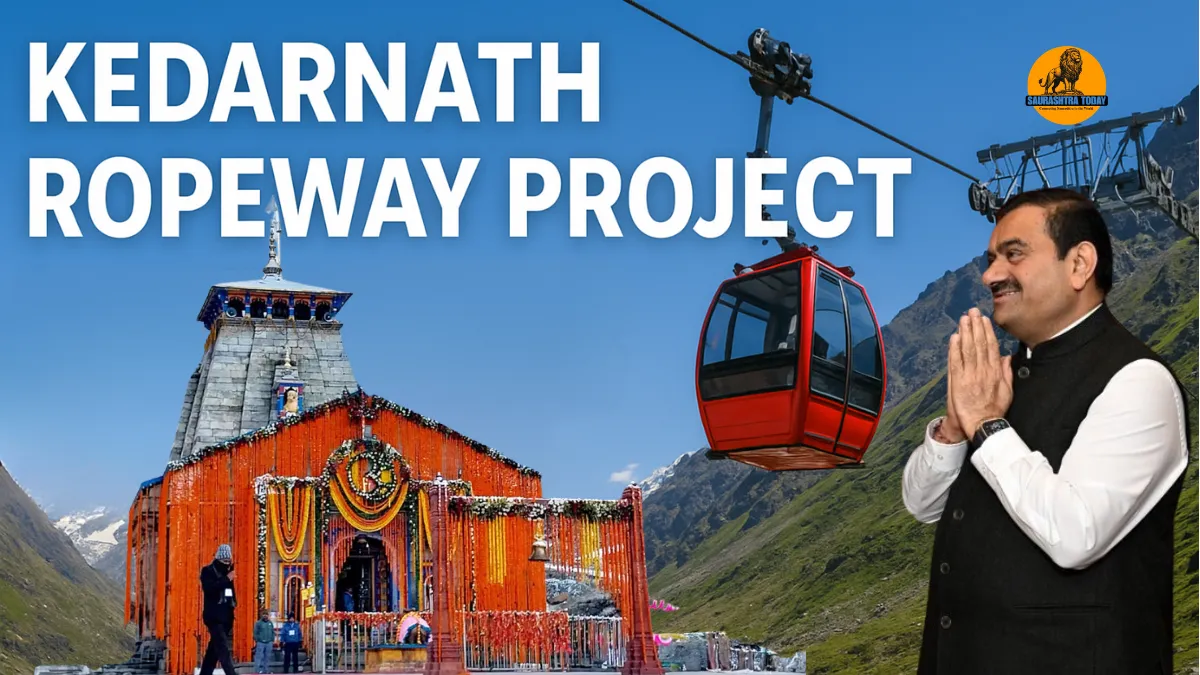Nestled in the serene Sahyadri hills near Vani Village in the Nashik district of Maharashtra, Saptashrungi Devi Temple is one of the most revered Shaktipeeths in India. This sacred shrine attracts thousands of devotees and travelers every year who come to seek the divine blessings of Goddess Saptashrungi Nivasini.
In this detailed guide, you will find everything you need to know about the Saptashrungi Ropeway Ticket Price, temple timings, prasad details, daily rituals, dress code, how to reach, nearby attractions, and more.
Meaning and Significance of Saptashrungi Devi Temple
The word “Saptashrungi” is derived from Sanskrit — “Sapta” meaning seven and “Shrungi” meaning peaks. Hence, the temple is believed to be the abode of the Goddess who resides among seven mountain peaks.
Located at an elevation of nearly 4,500 feet above sea level, the Saptashrungi hills form part of the majestic Western Ghats. Surrounding the temple are 108 natural water bodies, adding to the divine and mystical aura of this sacred place.
According to Hindu mythology, Saptashrungi Devi is said to be a manifestation of Goddess Durga, the embodiment of feminine energy and power. Devotees believe that the right hand of Goddess Sati fell at this site, making it one of the 51 Shaktipeeths in India and one of the three and a half Shaktipeeths of Maharashtra.
The Three and a Half Shaktipeeths of Maharashtra
Maharashtra is home to the famous “Saade Teen Shaktipeeth” (Three and a Half Shaktipeeths), each representing a sacred syllable of the divine Omkara (A–U–M and Bindu).
The four temples include:
- Mahalakshmi Temple, Kolhapur
- Tulja Bhavani Temple, Tuljapur
- Renuka Mata Temple, Mahur
- Saptashrungi Devi Temple, Vani
Among these, Saptashrungi Devi Temple is considered the half Shaktipeeth (Ardha Shaktipeeth) by many devotees.
Architecture and Divine Presence – The Swayambhu Murti
The Saptashrungi Temple is a magnificent two-storeyed structure built in front of a natural cave that forms the sanctum sanctorum. Inside the cave, one can witness the self-manifested (Swayambhu) idol of the Goddess carved directly on the rock face.
The Murti stands about 18 feet tall and features 18 arms, each holding a divine weapon such as the Trishul, Sudarshan Chakra, sword, bow, and conch. The idol is always beautifully adorned with jewelry, silk sarees, and sindoor, reflecting both grace and power.
Saptashrungi Devi Temple Timings
The temple remains open for devotees every day of the week.
Temple Timings:
5:00 AM to 9:00 PM
During major festivals such as Navratri, Purnima, and special Jagratas, the temple remains open late into the night, allowing devotees to offer prayers and participate in rituals without any rush.
Saptashrungi Devi Temple Prasad Details and Timings
The temple trust offers Prasad (holy food) to devotees daily. During major festivals, such as Navratri and Purnima, the Saptashrungi Devi Temple Trust provides free meals as a part of the community service (Annadan).
On regular days, the Prasad meal is available for a nominal charge of ₹15 per devotee.
Prasad Distribution Timings:
- 11:00 AM to 2:00 PM
- 7:00 PM to 9:00 PM
The food is prepared hygienically and served with devotion, offering both physical nourishment and spiritual satisfaction.
Daily Program Schedule at Saptashrungi Temple
Every day, the temple follows a strict schedule of rituals and aartis performed by the priests and devotees.
| Daily Ritual | Timing |
|---|---|
| Kakad Aarti (Morning) | 5:30 AM |
| Panchamrit Maha Puja | 7:00 AM – 9:00 AM |
| Mahanaivedya Aarti | 12:00 PM |
| Sanj Aarti (Evening) | 7:00 PM |
These rituals fill the temple premises with divine chants, conch sounds, and the fragrance of incense — a truly blissful experience for visitors.
Saptashrungi Devi Temple Dress Code
To maintain the sanctity of this holy site, devotees are advised to follow a modest dress code. The temple authorities do not permit revealing or inappropriate clothing.
Not Allowed at the Temple:
- Shorts
- Sleeveless tops
- Low-waist jeans
- Mini skirts
- Tight or transparent outfits
It is recommended to wear traditional Indian attire such as sarees, salwar suits, or kurtas for women and dhoti, kurta, or simple trousers for men.
Saptashrungi Ropeway – A Convenient Ride to the Divine Peak
One of the most remarkable attractions at the temple is the Saptashrungi Ropeway, a modern funicular trolley system that provides a quick and comfortable journey to the top of the hill.
The Saptashrungi Ropeway allows devotees to reach the temple — located about 1,400 meters above sea level — within just three minutes, eliminating the need to climb over 500 steep steps.
The trolley runs on an incline of 36 degrees and consists of two air-conditioned cabins, each capable of carrying up to 60 passengers per trip.
Saptashrungi Ropeway Ticket Price
Here are the latest details about the Saptashrungi Ropeway Ticket Price for pilgrims:
- Adult Ticket: ₹90 per person
- Children Ticket: ₹45 per person
(Ticket prices are subject to change as per temple administration.)
The affordable fare ensures that everyone — from elderly devotees to young travelers — can easily reach the temple without any physical strain.
Saptashrungi Ropeway Timings
The ropeway operates throughout the week, offering uninterrupted service to visitors.
Ropeway Operating Hours:
6:00 AM to 9:30 PM (Monday to Sunday)
Early mornings are ideal for devotees who wish to attend the Kakad Aarti, while evenings offer a scenic view of the illuminated hills and temple lights.
Accommodation – Where to Stay in Saptashrungi
For devotees planning an overnight stay, there are several comfortable and affordable accommodation options near the temple. The Shree Saptashrung Niwasini Devi Trust offers Bhakta Nivas (devotee lodges) equipped with clean rooms and basic amenities.
Saptashrungi Devi Temple Contact Information
For any assistance regarding temple facilities, accommodation, or donations, you can reach out to the temple administration:
Temple Trust Office:
Shree Saptashrung Niwasini Devi Trust
Mu. P.S. Shree Kshetra Saptashringgad, Ta. Kalvan, Dist. Nashik, Maharashtra
Email: saptashrungitrust@gmail.com
Telephone: (02592) 253351 / 253352
Mobile: 9422101118
Visitors can also visit the official temple website for more updates, special events, and festival schedules.
How to Reach Saptashrungi Devi Temple
Saptashrungi is well-connected to major cities of Maharashtra by road, rail, and air.
By Rail
The Nashik Road Railway Station is the nearest railhead, located about 70 kilometers from the temple. From the station, taxis and buses are easily available.
By Air
The nearest airport is Ozar (Nashik) Airport, which is approximately 53 kilometers away from the temple. Regular flights operate between Nashik and Mumbai.
By Road
The distance from Nashik city to Saptashrungi Temple is around 64.5 kilometers. You can hire a private cab or take a bus from the Nashik Central Bus Stand to Vani village. The roads are well maintained, making the journey smooth and scenic.
Nearby Tourist Attractions Around Saptashrungi Temple
Apart from the temple, visitors can explore several nearby attractions that reflect the natural and historical richness of the region:
- Shree Saptashrungi Nivasini Devi Temple Complex
- Dhodap Fort – A popular trekking destination and one of the highest peaks in Maharashtra.
- Chankapur Dam – Ideal for nature photography and picnics.
- Ozarkhed Dam – A peaceful spot surrounded by greenery and hills.
These nearby sites offer travelers a chance to blend spiritual experiences with adventure and relaxation.
Distances from Saptashrungi Devi Temple to Major Destinations
| Destination | Distance (km) |
|---|---|
| Saputara | 48 km |
| Deolali | 78 km |
| Igatpuri | 111 km |
| Shirdi | 138 km |
| Valsad | 142 km |
| Daman | 171 km |
Whether you are planning a quick visit or an extended pilgrimage tour, Saptashrungi serves as a convenient base for exploring Maharashtra’s spiritual and natural treasures.
Also read: History of Ambaji Temple – Significance, Legends, and Sacred Heritage
Festivals and Celebrations at Saptashrungi Temple
The temple witnesses massive gatherings during Navratri, Chaitra Purnima, and Ashwin Purnima. During these times, the entire hill is decorated with lights, and the air fills with devotional songs and chants.
Devotees from across India climb the steps or take the ropeway to offer prayers. The temple trust organizes free food distribution (Annadan) and cultural programs, adding to the festive spirit.
Tips for Visitors and Devotees
- Visit early in the morning to avoid crowds.
- Carry light woolens if you are visiting during winter.
- Ropeway tickets can be purchased directly at the base counter.
- Photography is allowed in specific areas; always respect temple rules.
- Try to participate in at least one Aarti session for a divine experience.
- Dispose of plastic and waste responsibly — help maintain the sanctity of the hills.
Spiritual Experience Beyond Worship
The charm of Saptashrungi Devi Temple lies not just in its religious significance but also in the breathtaking landscape surrounding it. The panoramic view from the top offers a glimpse of the Sahyadri ranges bathed in mist and sunshine — a perfect blend of devotion and nature.
Whether you take the traditional stairway or enjoy the smooth ride via the Saptashrungi Ropeway, the journey to the temple is a soulful experience of faith, peace, and rejuvenation.
Also read: Vani Temple Nashik: A Divine Abode of Saptashrungi Devi Amidst the Sahyadri Hills
Conclusion
Saptashrungi Devi Temple stands as a symbol of unwavering faith and divine feminine power. The introduction of the Saptashrungi Ropeway has made it easier for pilgrims of all ages to reach the temple and experience its sacred energy without physical strain.
With affordable Saptashrungi Ropeway Ticket Prices, well-managed facilities, and scenic surroundings, this holy destination continues to be one of Maharashtra’s most cherished pilgrimage and tourist spots.
If you are planning a trip to Nashik or nearby regions, make sure to include Saptashrungi Devi Temple in your itinerary — a place where spirituality meets serenity in the heart of the mountains.



















